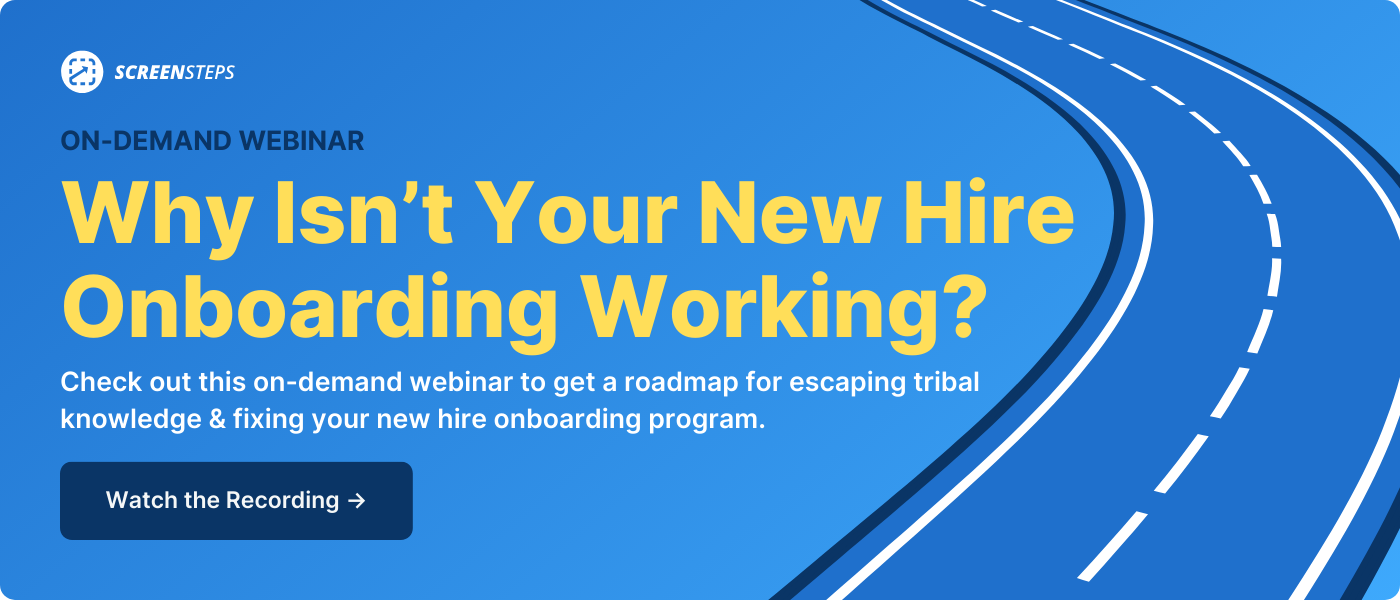3 Common Mistakes Companies Make When Onboarding New Hires
How well is your new hire training program working?
Does it take months or even more than a year for new hires to become proficient at their jobs? Do new hires leave training confused?
Yet, you've tried to create a new hire training curriculum for your new hires, but something isn't working.
As the Head Consultant at ScreenSteps — a knowledge ops solution that helps you better train employees — I've worked with dozens of businesses in a bunch of different industries that run into this same problem. And, typically, these businesses are making one or all of these mistakes.
Watch the 3-minute video for three common mistakes trainers make when onboarding new employees. Plus, I include tips on how to fix those mistakes. Then dive into more details below.
Mistake #1: Building a training plan that doesn't match employee tasks
One mistake trainers make when building the new hire training curriculum is they don't take the time to understand the exact role and responsibilities of these new hires. You aren't clear on what new hires need to do on their job.
Because of this, the information covered during training doesn't adequately cover the new hire's role and responsibilities.
How to fix it
Before creating your training curriculum, take the time to align with the people who will oversee the new hires on their jobs. This includes supervisors, managers, etc. You may even consider talking to employees currently in that role the new hires will fill.
Together you can identify all the tasks and procedures that a specific role will need to perform. After you have a comprehensive list, then you can start building your training plan.
How to gather the roles and responsibilities
At ScreenSteps, we recommend that you hold a Find & Follow Workshop. The workshop helps your training and operations teams align. In the workshop, you brainstorm all the different responsibilities. Download this free roles and responsibilities brainstorm sheet.
Mistake #2: Relying on shadowing
The second mistake trainers make with employee training is they rely on shadowing to really teach new hires to do their jobs.
Because training focuses on sharing information and memorizing information, new hires leave training without all the necessary skills for their jobs. They don't know how to DO anything.
That's why many companies use shadowing as part of the training curriculum. New hires spend days or weeks post-training watching tenured employees do the job.
The problem with this is it is once again passive learning. New hires are watching someone else do the job which means they aren't engaged with the learning experience.
How to fix it
Instead of spending days or weeks having new hires watch experts do the job, give new hires hands-on experience. During training, run practice activities that mimic realistic job scenarios.
New hires will role-play different procedures and outcomes so that they know how to handle different situations when they are on their own.
Mistake #3: Sharing step-by-step guides in PowerPoint
You want to cover everything in training, right? That isn't exactly the case. At least, that's not the case when it comes to actionable knowledge.
There are two types of knowledge you need to teach employees: foundational knowledge and actionable knowledge. You train employees on that knowledge differently.
For foundational knowledge, PowerPoint presentation works. However, for actionable knowledge, such as step-by-step procedures, slide decks and lectures don't work.
Learn more about the difference between foundational and actionable knowledge here.
How to fix it
Create an internal Google. That means that you have a cloud-based knowledge management system — like a knowledge base or knowledge ops platform — where employees can type in a question and pull up a guide to help them handle a task.
You'll create and store your digital guides in this software so it is easy for employees to find and follow the guides.
That way, employees don't have to rely on their memories.
Fix these mistakes with a better onboarding curriculum
When you move away from traditional training techniques and adjust your training curriculum to include these fixes, it helps your employees become more independent in their jobs.
The Find & Follow Framework — created by ScreenSteps — is a methodology to help you train your employees to work more confidently, efficiently, and independently in 30 days or less.
Companies that have adopted Find & Follow have cut time to proficiency by up to 85%.
Want to improve your employee training plan and spend less time in onboarding?
Download the free e-book on new hire training. The guide walks you through how to create your own new hire training program.


.png)

